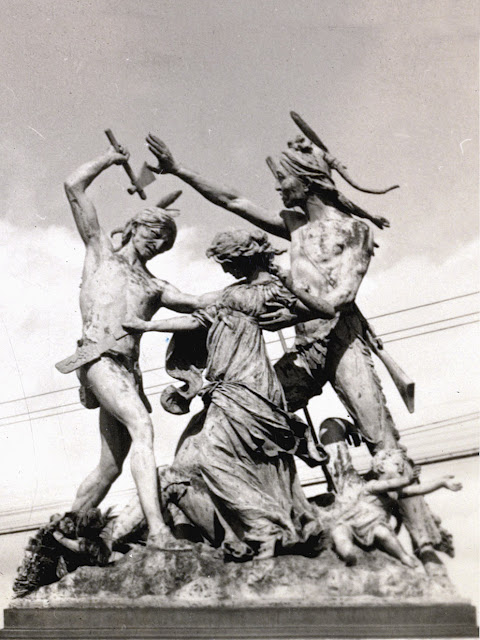56 conventionalized Indian heads support the corbels of the Dumbarton, or Buffalo Bridge that carries Q street over Rock Creek, in Washington DC. They were designed by architect Glen Brown and sculpted by Alexander Phimister Proctor based on the life mask of Kicking Bear which they found in the Smithsonian.
Kicking Bear (Mato Wanartaka) 1846-1904Kicking Bear, Mato Wanartaka (Lakota, Matȟó Wanáȟtake) (1846-1904), born to Black Fox and Iron Cedar Woman of the Oglala Sioux, was brother to Moses Flying Hawk and first cousin to Crazy Horse (their mothers were sisters). With Kicking Bear's marriage to Chief Big Foot's daughter, Woodpecker Woman, Kicking Bear became a band chief of the Minneconjou Sioux and fought for the Lakota Nation during major battles, including the Rosebud and the Battle of Little Bighorn. Kicking Bear accompanied Short Bull to Nevada in 1889 to learn about the Ghost Dance from Wovoka, leader of the Ghost Dance movement. The Ghost Dance was effectively subdued following the Massacre at Wounded Knee Creek in 1890, and leaders of the movement, including Kicking Bear and Short Bull, were imprisoned at Fort Sheridan, Illinois. Kicking Bear and other incarcerated Native men and women were released from prison to join the European tour of Buffalo Bill's Wild West for the season of 1891-92. Kicking Bear and Short Bull, among others, were sent back to Fort Sheridan when they insisted on returning home prematurely, sailing from Glasgow on board the Corean March 4, 1892. Kicking Bear and Short Bull were the last to be released from Fort Sheridan. During the 1891-92 tour, Kicking Bear was widely promoted as the "Fighting Chief of the Ghost Dancers."
Kicking Bear came to Washington in 1896 on a diplomatic mission. Photos and a life mask were taken as a means of preserving the likeness of the American Indian, then widely seen as a vanishing race. His life-mask and costume were displayed in the museum. (See Krieger, 1928)
Kicking Bear's life mask provided a "typical" Native American face for use in representing a type. This display was originally labeled as "Kicking Bear" in the museum but it came to be labeled, "Sioux Warrior in Full Costume."
The Corbels were started on Indian heads —we were fortunate enough to secure a life mask of Kicking Bear from the National Museum, which gave us a good type of head as a basis for the conventionalized modelling.This was not Kicking Bear's only foray into the popular representation of Native Americans. He performed in Buffalo Bill's Wild West Show, after all, —in return for the commutation of his sentence and release from Fort Sheridan. And his likeness was used to represent Black Partridge in the 1892 Fort Dearborn Massacre Monument, sculpted by Carl Rohl-Smith.
So that is the other paradox of the Fort Dearborn Massacre statue. Short Bull, the dreamer, the man of peace, who urged his followers to refrain from hostile acts against the whites, is depicted as a murderous young brave. But Kicking Bear, the ruthless warrior, who used the new religion as a means of inciting the Sioux to rebellion, is the “noble red man” saving a white woman's life. And thus they are perpetuated in enduring bronze!The first paradox was that the sculptor chose to immortalize an incident that probably didn't happen. Kicking Bear was aware of the twist in roles. Watson quotes a contemporary writer, probably Joseph Kirkland, that:
It chanced that the real disposition of the two principal models were the reverse of their assumed characters, and Kicking Bear (who when wearing his native dress and war paint carried a string of six scalps) was amused that he was assigned the more humane part. “‘Me, good Injun’ he cried, ‘Him, bad Injun!’ and he laughed loudly at the jest.”
An 1892 article sub-titled Sanguinary Kicking Bear Sitting the Model of a Life Saver, was widely circulated and noticed the same irony.
Conceived in a sensationalist, luridly violent mode, the sculpture was long criticized by American Indian activists and was removed from public view in 1997.










No comments:
Post a Comment